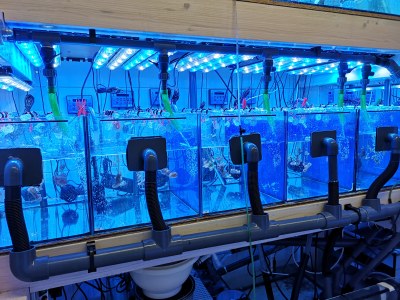Marine pollution: Synthetic fibers and tire abrasion have the strongest impact on corals
Studies on the effects of microparticles of different materials on reef-building corals and their feeding behavior
No. 22 • 14 February 2024

Corals feed on plankton, which they catch from the seawater. Due to the increasing pollution of the oceans, they also ingest tiny plastic particles. Sometimes, the corals are unable to expel the microplastics from their bodies. Instead, they store it in their calcareous skeleton, which can be bad for some species: they grow slower, develop coral bleaching, or necrosis. Dr. Jessica Reichert has been conducting extensive research on the impact of plastic pollution on coral reefs at Justus Liebig University Giessen (JLU). Now, together with other scientists, she has investigated the impact of the smallest particles of our waste on reef-building corals. Synthetic fibers from clothing and tire abrasion had the strongest impact. Yet, the researchers do not consider the studied corals to be endangered by the current concentration of microplastics. Two studies on coral-microplastic research have now been published in the journal “Science of The Total Environment”.
For the first study, the research team exposed two coral species to four different microparticles from the main sources of pollution for eight weeks: Plastic waste from the environment, synthetic fibers from clothing, residues from the automotive sector – tire abrasion, brake abrasion, and paint chips – as well as a polymer microplastic that consisted of polyethylene particles, the material most found in the environment. These particles were smaller than one millimeter. In water contaminated with these microparticles, the growth, photosynthesis, and health of the two reef-building coral species, cauliflower coral (Pocillopora verrucosa) and hood coral (Stylophora pistillata), were studied. These two coral species are known to frequently ingest microplastics.

Synthetic fibers triggered the most changes in coral physiology – possibly because they become entangled in the coral colonies and cleaning mechanisms that can be effective for other microparticles do not work here. Tire abrasion also had a significant impact on the corals. Overall, the cauliflower coral was more affected than the hood coral, which could be due to differences in the growth form and feeding strategy of the coral species. The microparticles affected growth: both species increased more in volume, accompanied by reduced calcification in the cauliflower coral. “We suspect that the increase in volume is due to the incorporation of microparticles into the skeletal structure”, says study leader Dr. Reichert.
Overall, however, the effects of the microparticles on the corals during the eight-week trial period were minimal. Apparently, the corals can compensate for the stress caused by the tested microparticle concentration over a period of time. This could be due to the fact that the photosynthesis of the algae, which live in symbiosis with the corals, was increased in both coral species by the microparticles. The reasons for this are still unclear. “This upregulation could be a mechanism to compensate for the reduced food intake caused by microparticles and the associated loss of energy”, says Dr. Reichert. The increased photosynthesis appears to successfully mitigate the effects of microparticles, as exposure during the experimental period did not affect surface growth and coral health.
“Our results also show that different microparticles have different effects on coral physiology”, says Dr. Reichert. “Therefore, future studies should use particle mixtures to better mimic the microparticles found in the oceans and more accurately assess their effects on corals. To protect the highly important coral reef ecosystems, which are already threatened by climate change, it is particularly important to take measures to reduce residues from synthetic fiber clothing and the automotive sector, which obviously have the greatest impact on the corals studied.”

In addition to JLU researchers, scientists from the Alfred Wegener Institute – Helmholtz Center for Polar and Marine Research on Helgoland and Wageningen Marine Research in the Netherlands were also involved in this study.
In the second study, JLU researchers gained insights into the feeding behavior of a wide range of reef-building coral species. They showed that these corals react just as frequently to microplastics as to food particles, but clearly reject naturally occurring non-food particles such as sand. In contrast to natural food, however, the corals rejected most of the microplastics after ingestion. Yet, microplastics can be masked by biotic factors such as a biofilm on the particles, increasing the likelihood of triggering feeding behaviors
Another result of this study: the concentration-dependent risk assessment showed that corals are probably not endangered by microplastics at the current average environmental concentrations. Dr. Reichert, the first author of this study, explains: “However, corals that feed a lot on particles, such as the pineapple coral Blastomussa merleti and the cauliflower coral, which is also endangered by other stressors, could react sensitively to the increasing pollution of the oceans by microplastics. In the case of the cauliflower coral, we have already seen that it is particularly strongly affected by synthetic fibers and tire abrasion.”
- Publications
Jessica Reichert, Vanessa Tirpitz, Katherine Plaza, Elisabeth Wörner, Luisa Bösser, Susanne Kühn, Sebastian Primpke, Patrick Schubert, Maren Ziegler, Thomas Wilke: Common types of microdebris affect the physiology of reef-building corals. Science of The Total Environment,
Volume 912, 2024, https://doi.org/10.1016/j.scitotenv.2023.169276
Jessica Reichert, Vanessa Tirpitz, Mareike Oponczewski, Chieh Lin, Niklas Franke, Maren Ziegler, Thomas Wilke: Feeding responses of reef-building corals provide species- and concentration-dependent risk assessment of microplastic. Science of The Total Environment,
Volume 913, 2024, https://doi.org/10.1016/j.scitotenv.2023.169485
- Contact
Dr. Jessica Reichert
Department of Animal Ecology & Systematics
Justus Liebig University Giessen
Hawai'i Institute of Marine Biology, University of Hawai'i
E-mail: jreichert.sci
Presse, Kommunikation und Marketing • Justus-Liebig-Universität Gießen • pressestelle
